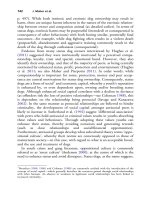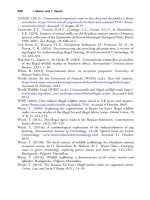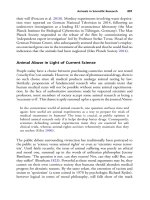The palgrave international handbook of a 121
Bạn đang xem bản rút gọn của tài liệu. Xem và tải ngay bản đầy đủ của tài liệu tại đây (27.71 KB, 1 trang )
Animal Hoarding
111
There are unique human problems associated with animal hoarding cases as
well. In some animal-hoarding situations minor children, dependent elderly
persons, or disabled adults are present and are also victims of this behavior.
Serious unmet human health needs are commonly observed, and the conditions often meet the criteria for adult self-neglect, child neglect, or elder abuse
(Nathanson 2009). Animal hoarding also creates risk of injury or zoonotic
disease transmission to occupants of the property, as well as responders.
Demographics
Animal hoarders come from varied backgrounds, somewhat consistent with,
the stereotype of the neighborhood ‘cat lady’ who is pictured as an older,
single female, living alone. However, hoarding among men and younger
women, as well as couples, is also often encountered. Worth and Beck (1981)
reported that 70 % of the sample of 31 hoarders were unmarried women who
had cats, while in another study (Patronek 1999) 76 % of the sample were
women, 46 % were over 60 years of age, most were single, divorced, or
widowed and cats were most commonly involved. In another study (HARC
2002), 83 % were women, with a median age of 55 years, and nearly threequarters of the sample were single, widowed or divorced. In the review of
animal hoarders in Australia (Joffe et al. 2014), most were female (72.4 %)
and 79 % were 40–64 years of age at their first offence.
Animal hoarding behaviour cuts across all demographic and socio-economic
boundaries. Hoarding behavior has been discovered among doctors, nurses,
public officials, teachers, college professors, social workers and veterinarians, as
well as among a broad spectrum of socio-economically disadvantaged individuals (Patronek et al. 2006).
Animals and Objects
Cats and dogs are the most commonly hoarded species, but wildlife, exotic
animals and farm animals have been involved. One study of 71 animal hoarders
(HARC 2002) found that approximately 82 % of the cases involved cats, 55 %
dogs, 17 % birds, 6 % reptiles, 11 % small mammals, 6 % horses and 6 %
cattle, sheep or goats. A review of 56 cases of animal hoarding involving
prosecution of the hoarder noted that 46 % of cases involved dogs, 34 %
involved cats, with the remainder of the cases evenly divided between birds,
farm animals, rabbits and horses. The lower incidence of cat hoarding in this









